The Gulf of Suez is the southern branch of the northern Red Sea and is a small rift dating back 40 million years. This name was named according to the Egyptian city of Suez. Its length from the far south until it reaches the Suez Canal in the north is 280 km.
The Suez Canal, the first private canal between the Mediterranean Sea and the Red Sea.
The meaning of the word Gulf:
It is a flat of water surrounded by land on three sides. Most bays were formed or expanded as a result of sea level rise at the end of the Ice Age.
The importance of the Gulf of Suez for tourism:
· The Suez Gulf is adorned with an array of picturesque landscapes that captivate the senses. Miles of pristine beaches stretch along the coast, inviting visitors to relax in the warm embrace of the Egyptian sun. The golden sands offer a perfect backdrop for leisurely strolls, beach picnics, and, of course, stunning sunset views over the glistening waters of the Gulf.
· The Suez Gulf is a haven for marine biodiversity, with a rich tapestry of life beneath its waves. Snorkelers and divers can encounter an impressive array of fish, including the flamboyant parrotfish, the elusive seahorse, and the graceful lionfish. The Gulf’s waters are also frequented by larger marine species, such as dolphins and rays, adding an element of excitement to any underwater adventure.
· For those seeking an adrenaline rush or a serene escape, the Suez Gulf offers activities catering to all preferences. Snorkeling and diving excursions are readily available, allowing both novice and experienced enthusiasts to explore the vibrant underwater realms. Alternatively, beachcombers can bask in the sun, building sandcastles or simply enjoying the serenity of the Gulf’s shores.
Exploring the Rich Culture along the Suez Gulf, Egypt:
· One of the ways the local communities express their cultural identity is through traditional crafts and artistry. Walk through the narrow lanes of coastal villages, and you’ll encounter artisans weaving vibrant textiles, crafting intricate pottery, and creating unique handcrafted souvenirs. These creations not only serve as mementos for visitors but also contribute to the preservation of age-old artistic techniques passed down through generations.
· The Gulf’s coastal communities have sustained themselves for generations through traditional fishing practices. Witness the art of fishing as it has been practiced for centuries, with colorful boats dotting the horizon and fishermen skillfully casting their nets. Engaging with local fishermen provides insight into the symbiotic relationship between the communities and the sea, emphasizing the importance of sustainable practices.
· The communities along the Suez Gulf celebrate a calendar rich in cultural festivals and traditions. From vibrant music and dance festivals to religious celebrations, each event provides a window into the heart of local customs. Joining in the festivities allows visitors to forge connections with the community, fostering a deeper appreciation for the cultural tapestry that makes the Gulf a living, breathing entity.
Visitors can immerse themselves in the vibrant traditions of coastal communities, savor culinary delights infused with maritime heritage, and explore the underwater marvels of coral reefs. The Suez Gulf stands not only as a geographic marvel but as a living testament to the symbiotic relationship between humanity and nature, making it an unmissable destination for those seeking a holistic and immersive Egyptian experience.



Comment (0)